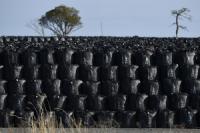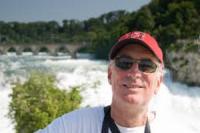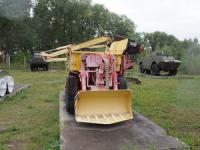-
Experimental box to track nuclear activity by rogue nations
Researchers are carrying out a research project at Dominion Power’s North Anna Nuclear Generating Station in Virginia that could lead to a new turning point in how the United Nations tracks rogue nations that seek nuclear power. The years-long project centers on a high-tech box full of luminescent plastic cubes stacked atop one another that can be placed just outside a nuclear reactor operated by, say, Iran. The box would detect subatomic particles known as neutrinos produced by the reactor, which can be used to track the amount of plutonium produced in the reactor core.
-
-
Nuclear power project abandoned as energy landscape changes, costs escalate
On Monday, after working nine years to expand a nuclear power plant in South Carolina, Santee Cooper and SCE&G announced they were pulling the plug on the $14 billion reactor project in Fairfield County. The companies cited rising costs, falling demand for energy, construction delays, and the bankruptcy of lead contractor Westinghouse. SCE&G customers have paid $1.4 billion through higher monthly utility bills – customers saw their rates increase nine different times over the last four years – and consumer groups in the state say they would demand that the money be refunded to consumers.
-
-
Russian hackers likely behind cyberattacks on U.S. nuclear operators: Experts
Russian government hackers are suspected to be behind a series of cyberattacks on U.S. nuclear operators. The attacks were similar to recent Russian attacks on Ukraine’s power infrastructure. Experts say that rhe attacks in Ukraine and the United States show that Russian hackers appear to be testing increasingly advanced tools to disrupt power supplies. “If you think about a typical war, some of the acts that have been taken against critical infrastructure in Ukraine and even in the U.S., those would be considered crossing red lines,” says one security expert.
-
-
How to save the U.S. nuclear industry
From Diablo Canyon on the central California coast to Turkey Point on the southeast tip of Florida, the United States is home to 99 nuclear power reactors at 62 nuclear plants generating roughly 20 percent of the nation’s electrical energy. But in an industry beset by disruptive technologies and intense competitive pressures, the future of nuclear energy in the U.S. is anything but certain. Economic pressures are taking their toll. Five nuclear plants have shut down nationwide since 2013, and 19 reactors are currently undergoing decommissioning.
-
-
Amid Texas nuclear waste site's financial woes, judge blocks merger
A federal judge has blocked the purchase of the company that runs Texas’ only nuclear waste dump — a setback in its proposal to accept spent nuclear fuel from across the country. Wednesday’s ruling is the latest setback for a project that the company initially suggested it would start constructing by 2019.
-
-
Possible correlation found between TMI meltdown and thyroid cancers
Three Mile Island (TMI), located near Harrisburg, Pennsylvania, had a partial meltdown accident on 28 March 1979. During the accident, radiation was released into the environment, which the United States Nuclear Regulatory Commission said was in small amounts with no detectable health effects. Penn State College of Medicine researchers have shown, for the first time, a possible correlation between the partial meltdown at TMI and thyroid cancers in the counties surrounding the plant.
-
-
New cracks found in aging Belgian nuclear power plant
More micro-cracks have been discovered at the Belgian Tihange 2 nuclear reactor near the German border. safe. The worries in Germany about radiation leaks from the old reactor are strong. Last year, the government of the German state of North Rhine-Westphalia, which is on the other side of the Belgian-German border, purchased iodine tablets for distribution to the public in the event of radiation leak. Belgium relies on its two 40-year old nuclear reactors for 39 percent of its energy needs, and has extended the operational life of both, even though they were supposed to be decommissioned a decade ago.
-
-
Remote detection of hazardous radioactive substances
Remote detection of radioactive materials is impossible when the measurement location is far from its source. A typical radiation detectors, like Geiger-Muller counters can detect 1 milli Curie (mCi) of Cobalt-60 (60Co) at a maximum distance of 3.5 meters, but are inefficient at measuring lower levels of radioactivity or at longer distances. Researchers have developed a method for the remote detection of hazardous radioactive substances. With the help of this newly developed detection device, the detection of various types of radioactive materials can be done from a remote distance.
-
-
Argonne’s nuclear security training team has a global reach
At Argonne National Laboratory, a team of experts is training foreign scientists and engineers in the peaceful uses of nuclear energy and technology. Although the building is more than 4700 miles from the headquarters of the International Atomic Energy Agency (IAEA) in Vienna, the team is helping it uphold decades of international nuclear cooperation. Over the years, Argonne has taught more than 220 courses to more than 5,000 students, many of whom became leaders of nuclear safety and security abroad.
-
-
U.S. nuclear watchdog greatly underestimates potential for nuclear disaster

The U.S. Nuclear Regulatory Commission (NRC) relied on faulty analysis to justify its refusal to adopt a critical measure for protecting Americans from the occurrence of a catastrophic nuclear-waste fire at any one of dozens of reactor sites around the country, a new study shows. Fallout from such a fire could be considerably larger than the radioactive emissions from the 2011 Fukushima accident in Japan. These catastrophic consequences, which could be triggered by a large earthquake or a terrorist attack, could be largely avoided by regulatory measures that the NRC refuses to implement.
-
-
New plutonium discovery to help nuclear waste clean-up
Plutonium has long been part of many countries’ nuclear energy strategies, but scientists are still unlocking the mysteries behind this complicated element and seeing how they can use heavier, nuclear elements to clean up nuclear waste. Now, new research shows that plutonium does not exactly work the way scientists thought it did. The findings will contribute to the effort to develop technologies to clean up nuclear waste.
-
-
Nuclear storage tunnel collapses at Washington State’s Hanford site; employees evacuated
Hundreds of workers have been forced to “take cover” after a tunnel in a nuclear finishing plant collapsed at the Hanford Nuclear Reservation in southeastern Washington state. The Department of Energy activated its Emergency Operations Center following the collapse. Nuclear experts have criticized to storage and safety practices at the site, calling it “the most toxic place in America” and saying it was “an underground Chernobyl waiting to happen.”
-
-
How will the federal government protect nuclear safety in an anti-regulatory climate?

The Trump administration and congressional Republicans have undertaken a wide-ranging effort to shrink the federal government’s regulatory footprint. Much attention has focused on high-profile targets, such as the Environmental Protection Agency. But this trend also has major implications for other agencies. One example is the U.S. Nuclear Regulatory Commission (NRC), which oversees safety across a complex, privately owned network of nuclear power plants, used fuel storage facilities and other sites related to civilian uses of nuclear energy. The NRC and the system it regulates exemplify what some scholars call a “high reliability organization” – one that cannot be allowed to fail, because the consequences would be grave (two examples of failures of external oversight: Chernobyl in 1986 and Fukushima in 2011). A high reliability organization is not automatically a highly reliable organization. Reliability is an ongoing accomplishment involving continuous learning, sustained vigilance and a strong system of checks and balances. Moving forward in an anti-regulatory climate, with so many complex challenges facing the agency, it is essential to ensure independent leadership, public transparency and adequate resources to support the NRC’s mission.
-
-
Nextgen robots for nuclear clean-up

The cost of cleaning up the U.K.’s existing nuclear facilities has been estimated to be between £95 billion, and £219 billion over the next 120 years or so. The harsh conditions within these facilities means that human access is highly restricted and much of the work will need to be completed by robots. Present robotics technology is simply not capable of completing many of the tasks that will be required. A research a consortium to build the next generation of robots that are more durable and perceptive for use in nuclear sites.
-
-
“Fishing out” radioactive elements from nuclear waste
Scientists have revealed how arsenic molecules might be used to “fish out” the most toxic elements from radioactive nuclear waste — a breakthrough that could make the decommissioning industry even safer and more effective. “Nuclear power could potentially produce far less carbon dioxide than fossil fuels, but the long-lived waste it produces is radioactive and needs to be handled appropriately,” one scientists said.
-
- All
- Regional
- Water
- Biometrics
- Borders/Immig
- Business
- Cybersecurity
- Detection
- Disasters
- Government
- Infrastructure
- International
- Public health
- Public Safety
- Communication interoperabillity
- Emergency services
- Emergency medical services
- Fire
- First response
- IEDs
- Law Enforcement
- Law Enforcement Technology
- Military technology
- Nonlethal weapons
- Nuclear weapons
- Personal protection equipment
- Police
- Notification /alert systems
- Situational awareness
- Weapons systems
- Sci-Tech
- Sector Reports
- Surveillance
- Transportation
Advertising & Marketing: advertise@newswirepubs.com
Editorial: editor@newswirepubs.com
General: info@newswirepubs.com
2010-2011 © News Wire Publications, LLC News Wire Publications, LLC
220 Old Country Road | Suite 200 | Mineola | New York | 11501
Permissions and Policies
Editorial: editor@newswirepubs.com
General: info@newswirepubs.com
2010-2011 © News Wire Publications, LLC News Wire Publications, LLC
220 Old Country Road | Suite 200 | Mineola | New York | 11501
Permissions and Policies
